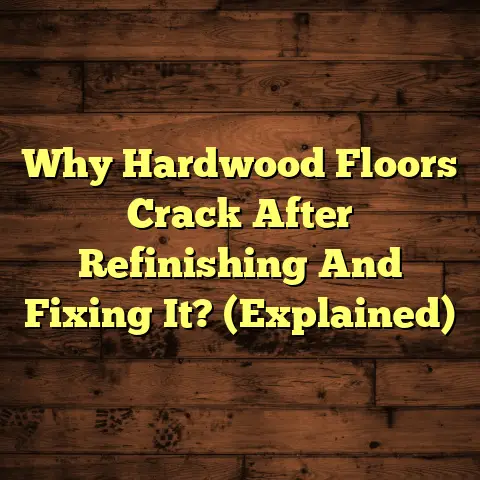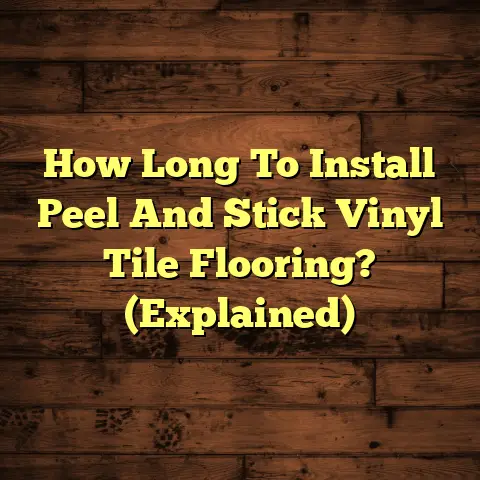No Subfloor Under Hardwood? (1 BIG Mistake!)
And let me tell you, I’ve seen it all when it comes to flooring.
From DIY disasters to stunning transformations, I’ve learned a thing or two about what works and, more importantly, what doesn’t.
These days, everyone’s obsessed with modern design, right? Open floor plans, that minimalist vibe, and bringing natural elements indoors.
Hardwood flooring has become a staple, and for good reason! It adds warmth, elegance, and a touch of timeless beauty to any space.
Think about those gorgeous, wide-plank oak floors you see in magazines – they create a seamless flow and complement any style.
But here’s the deal: achieving that magazine-worthy look isn’t just about picking the right wood.
It’s about the foundation.
And that’s where the subfloor comes in.
Believe me, skipping this step is one huge mistake that can cost you big time.
Let’s dive into why a subfloor is absolutely essential for your hardwood floors.
Section 1: Understanding Subfloors
So, what exactly is a subfloor?
Think of it as the unsung hero beneath your beautiful hardwood. It’s the structural layer that sits between your floor joists and your finished flooring.
It’s the base upon which your dreams are built.
Imagine a cake without a solid base – it’d crumble, right? Same goes for your hardwood floor.
There are several types of subfloors you’ll commonly encounter, each with its own pros and cons.
-
Plywood: This is probably the most common type. It’s made of layers of wood veneer glued together, making it strong and relatively inexpensive.
I typically recommend using a minimum thickness of 3/4″ for hardwood installations.
-
Oriented Strand Board (OSB): OSB is similar to plywood, but it’s made of compressed wood strands. It’s another budget- friendly option, but it can be more susceptible to moisture damage than plywood.
-
Concrete: You’ll often find concrete subfloors in basements or on the ground level. While concrete itself is strong, it can be prone to moisture issues, which need to be addressed before installing hardwood.
I always recommend a proper moisture test and vapor barrier when working with concrete.
-
Cement Board: This type of subfloor is often used in bathrooms or other areas prone to moisture. It’s water-resistant and provides a stable surface for tile or other flooring materials.
So, why bother with a subfloor at all? Here’s a quick rundown of the benefits:
-
Stability: A subfloor provides a solid, level surface for your hardwood. This prevents the planks from flexing, warping, or buckling over time.
-
Insulation: It adds an extra layer of insulation, helping to keep your home warmer in the winter and cooler in the summer.
-
Moisture Control: A properly installed subfloor acts as a barrier against moisture, protecting your hardwood from water damage and mold growth.
-
Soundproofing: It can help to dampen sound, making your home quieter and more peaceful. Especially important in multi-story homes.
Section 2: The Importance of a Subfloor Under Hardwood
Now, let’s get down to the nitty-gritty of why a subfloor is absolutely essential for hardwood flooring.
Think of it as the foundation of your entire flooring system.
Without it, you’re setting yourself up for a world of headaches.
One of the biggest reasons is levelness.
Hardwood needs a perfectly flat and even surface to be installed correctly. Any dips, bumps, or unevenness in the underlying surface will translate directly into your finished floor, creating an eyesore and potentially causing structural problems.
Imagine trying to build a house on a wobbly foundation – it’s just not going to work, right?
A subfloor acts as a smoothing layer, creating a consistent and stable base for your hardwood planks.
This prevents warping, buckling, and those annoying squeaks that can drive you crazy.
Moisture is another huge enemy of hardwood.
Wood is a natural material, and it’s highly susceptible to changes in humidity and moisture levels.
If moisture seeps up from the ground or from the crawl space below, it can cause the wood to swell, warp, and even rot.
A subfloor acts as a barrier against this moisture, protecting your hardwood from damage and extending its lifespan.
I cannot stress this enough: always use a moisture barrier between the subfloor and the hardwood, especially in areas prone to dampness.
Now, let me share a story from my own experience.
A few years back, I got a call from a homeowner who had installed beautiful new hardwood floors throughout their living room. They skipped the subfloor to save money.
Within a few months, the floor started to buckle and warp, especially near the exterior walls.
Turns out, moisture was seeping up from the crawl space below, causing the wood to swell.
The cost to repair the damage was astronomical, far exceeding the money they had saved by skipping the subfloor in the first place.
I had to rip out the entire floor and install a proper subfloor with a moisture barrier.
Trust me, it was a costly and frustrating experience for everyone involved.
Here’s a quote from the National Wood Flooring Association (NWFA) Installation Guidelines:
“A properly prepared subfloor is essential for a successful wood flooring installation. The subfloor must be structurally sound, clean, dry, and level.”
They don’t mess around!
Section 3: Consequences of Installing Hardwood Without a Subfloor
Alright, let’s talk about the real consequences of skipping that crucial subfloor.
I’ve seen firsthand the problems it can cause, and believe me, it’s not pretty.
First off, let’s address the issue of uneven surfaces.
Without a subfloor to provide a level base, your hardwood floor will inherit any imperfections in the underlying structure.
This can lead to dips, bumps, and an overall uneven appearance.
Not only does this look bad, but it can also create tripping hazards and make it difficult to place furniture evenly.
Then there’s the noise factor.
A subfloor helps to dampen sound, preventing those annoying squeaks and creaks that can plague a poorly installed hardwood floor.
Without a subfloor, every step you take will be amplified, creating a noisy and unpleasant living environment.
Imagine trying to relax in your living room while hearing every footstep from the floor above – not exactly peaceful, is it?
Heat loss is another often-overlooked consequence.
A subfloor adds an extra layer of insulation, helping to keep your home warmer in the winter and cooler in the summer.
Without it, you’ll likely experience increased heat loss, leading to higher energy bills and a less comfortable living environment.
And let’s not forget about the structural integrity of your floor.
A subfloor provides essential support for your hardwood, preventing it from flexing, warping, and potentially collapsing under heavy loads.
Without it, your floor is much more vulnerable to damage and may not be able to withstand the wear and tear of everyday life.
I’ve seen floors that have literally started to sag in the middle due to the lack of a proper subfloor.
It’s not a pretty sight, and it’s definitely not something you want to experience in your own home.
Let me give you another real-life scenario:
I was called in to inspect a home where the hardwood floors had been installed directly over the floor joists, with no subfloor whatsoever.
The homeowners had tried to save money by cutting corners during the installation process.
Big mistake.
Over time, the floor had started to sag, and the hardwood planks were beginning to separate.
The homeowners were experiencing significant heat loss, and the floors were incredibly noisy.
The cost to repair the damage was substantial, involving removing the entire floor, installing a proper subfloor, and then reinstalling the hardwood.
They ended up paying far more than they would have if they had simply installed a subfloor in the first place.
Section 4: Installation Guidelines for Hardwood with a Subfloor
Okay, let’s get practical.
I’m going to walk you through the proper installation techniques for hardwood flooring with a subfloor.
Follow these steps, and you’ll be well on your way to a beautiful and long-lasting floor.
-
Preparation is Key:
- Inspect the Subfloor: Make sure it’s clean, dry, and level. Repair any damage or imperfections before proceeding.
- Acclimation: Allow the hardwood flooring to acclimate to the room’s temperature and humidity for at least 3-5 days before installation. This helps to prevent warping and shrinking after installation.
- Moisture Barrier: Install a moisture barrier over the subfloor to protect the hardwood from moisture damage. Overlap the seams by at least 6 inches and tape them securely.
-
Laying the Hardwood:
-
Start Straight: Begin by laying the first row of hardwood planks along a straight line, using spacers to maintain a consistent gap between the planks and the wall.
- Stagger the Joints: Stagger the end joints of the planks to create a more visually appealing and structurally sound floor.
- Nail or Glue: Use a nail gun or wood adhesive to secure the planks to the subfloor. Follow the manufacturer’s instructions for proper spacing and application.
- Cut Carefully: Use a saw to cut the planks to fit around doorways, corners, and other obstacles.
-
Finishing Touches:
-
Install Baseboards: Install baseboards to cover the gap between the hardwood floor and the wall.
- Apply Finish: Apply a protective finish to the hardwood floor to protect it from scratches, stains, and wear.
- Clean Up: Clean up any debris or dust from the installation process.
Tools You’ll Need:
- Measuring tape
- Saw
- Nail gun or wood adhesive
- Moisture meter
- Moisture barrier
- Spacers
- Hammer
- Safety glasses
- Gloves
Ensuring a Flawless Finish:
- Take Your Time: Don’t rush the installation process. Take your time to ensure that each plank is properly aligned and secured.
- Check for Levelness: Use a level to check for unevenness as you go. Make adjustments as needed to ensure a perfectly flat floor.
- Follow Instructions: Always follow the manufacturer’s instructions for the specific type of hardwood flooring you’re installing.
Section 5: The Long-term Benefits of Proper Installation
Alright, let’s talk about the long-term benefits of doing things the right way.
I’m talking about investing in a proper subfloor and following proper installation techniques.
First and foremost, you’ll be increasing your property value.
A well-installed hardwood floor is a major selling point for any home.
It adds a touch of luxury and elegance that buyers are willing to pay for.
But more than that, you’ll be ensuring the longevity of your flooring.
A properly installed hardwood floor can last for decades, providing you with years of beauty and enjoyment.
Think of it as an investment in your home that will pay dividends for years to come.
And let’s not forget about the overall satisfaction you’ll experience with your floor.
There’s nothing quite like walking into a room and being greeted by the warm, inviting beauty of a perfectly installed hardwood floor.
It’s a feeling that’s hard to put into words, but it’s definitely worth the effort.
I’ve had countless clients tell me how much they love their new hardwood floors, and how it’s completely transformed their homes.
And that’s what it’s all about, right?
Creating a space that you love and that you’re proud to call your own.
Conclusion
So, there you have it.
The importance of a subfloor under hardwood flooring cannot be overstated.
It’s the foundation of your entire flooring system, and skipping this crucial step can lead to a world of problems.
From uneven surfaces and increased noise levels to heat loss and compromised structural integrity, the consequences of installing hardwood without a subfloor are simply not worth the risk.
Remember, that magazine-worthy aesthetic you’re dreaming of starts with a solid foundation.
Don’t let a shortcut undermine your investment.
Prioritize proper installation techniques, and ensure that your hardwood floors remain a beautiful and lasting feature of your home for years to come.





